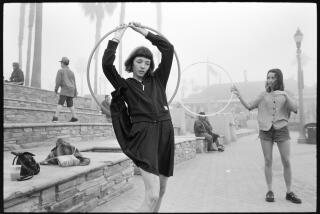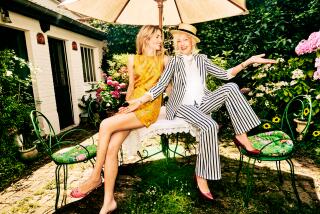Riding herd on hippie hygiene
Shaun Duffy and Sophia Costas never suspected they’d chosen a career path that would eventually require them to find 6,000 people willing to grow out their body hair.
“A lot of the looking for extras in ‘Taking Woodstock’ was about hair,” said Costas, who, along with Duffy, served as extras casting director on director Ang Lee’s new film about the landmark music and cultural event. “We couldn’t have any really short haircuts. And because several people appear nude in the movie, we also had to make sure that they had hair in all the right places!”
Duffy and Costas weren’t always so concerned about hippie hygiene. Duffy’s first loves were football and basketball, and Costas worked for years as a speech and language therapist. Both interviewed for casting jobs on a whim and got hooked for life.
Whether casting Hare Krishnas in the 2003 telefilm “Angels in America” or the New York City Fire Department soccer team in 2008’s “The Accidental Husband,” Costas enjoys “meeting people I would never meet in my normal life.”
Duffy, who’s worked on 2005’s “War of the Worlds” and 2007’s “American Gangster,” among other films, said, “I must shake 1,000 hands a day. It’s a crazy social experiment where they get to learn about me, and I get to learn about them. So it becomes, ‘I’ve touched 1,000 people’s lives today, and they’ve touched mine.’ ”
In the case of “Taking Woodstock,” some of those people happened to be naked, hairy and covered in mud.
The numbers game: To cast 6,000 extras for “Taking Woodstock,” Duffy and Costas extended their efforts across several states. “We had open calls in Hudson, Albany and New Lebanon, N.Y., and Brattleboro and Bennington, Vt.,” Duffy said. “We also spread the net even further with our advertising, going to New Hampshire, Massachusetts and Connecticut. I put ads in some papers pretty much everywhere I could. And then for weeks, I did everything from calling yoga studios to skate shops.
“The search never stopped because the demand for bodies that looked right never stopped. [We needed] everything from bikers to [people from] the retreat home for the Jewish community that was across the street, to the townspeople to the police to the college kids to the yogis to everyone. So I had an open office policy to encourage anyone to just come in and say hello, fill out the form and take a picture.”
Natural instincts: Costas and Duffy sought period faces, bodies and, of course, hair. “Not only did they have to look like they would be attending Woodstock, but they had to look like they were in 1969,” Costas said. “People looked different 40 years ago. People didn’t work out as much. They were lighter built, and they didn’t have muscle definition in 1969 unless they were body builders. And there is a natural look that we were going for, particularly for the women so that they didn’t have plucked eyebrows. We asked the women not to wear makeup. They couldn’t have fake fingernails or modern manicures, and the same thing with their toenails. And also people didn’t have tattoos. We had to make sure all of that was correct. That was a big challenge.”
Walk this way: Not everyone at the casting call had the right moves. “Each generation has their gait,” said Duffy. “There’s a gait that certain people have, whether they know it or not, like this physicality that you’d have in 1969. The rigidness of the ‘50s and the early ‘60s was loosening up. There was more fluidity to it. And today I feel like it’s different. It’s more of a swagger.”
Group effort: Director Lee sought to re-create specific scenes and moments from the historic concert. “If you’re familiar with the Woodstock documentary, you would have seen the road going to the concert, where it was so jammed that all the vehicles just stopped and people just started walking,” Costas said. “And so we shot that, and Ang Lee wanted to create vignettes of little incidents, some of which you saw in the documentary itself. People playing music, people sitting in the back of a pickup truck, hippie families with their children, people who brought their dogs. And so we had to group people that way, and I think it was very effective. It’s like a journey through this sea of people.”
Total recall: Even on a set with 6,000 extras, Duffy and Costas never forgot a face.
“I’ll end up knowing everyone that works at any time -- what they did, where they did it,” Duffy said. “I’m going through their forms day in and day out, flipping through, looking at the picture, looking at the name not just to memorize them but to remember them. I think they appreciate it. I go in the morning to greet everyone, to make sure that everyone is accounted for. And to be greeted in the morning by name, it makes you feel better. It extends that 30-second conversation you had earlier during the casting call into more of a relationship.”
--
More to Read
Only good movies
Get the Indie Focus newsletter, Mark Olsen's weekly guide to the world of cinema.
You may occasionally receive promotional content from the Los Angeles Times.








